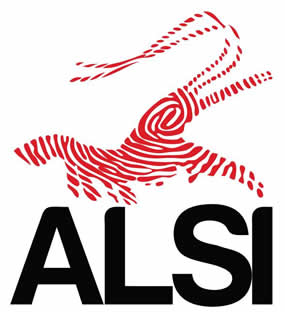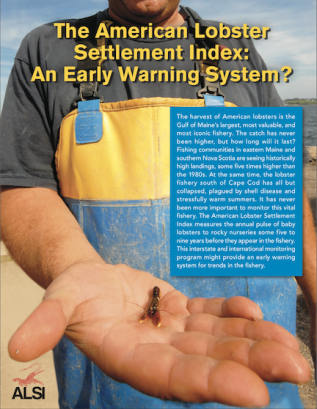
American Lobster Settlement Index (ALSI)
The American Lobster Settlement Index (ALSI) is an annual monitoring program that quantifies the pulse of newly settled lobsters that repopulate rocky coastal nursery grounds in New England and Atlantic Canada. Quantifying this segment of the life history is especially valuable because it is the only time when one can identify with certainty the strength of an individual year class. It is a pivotal life stage that both sheds light on the ocean processes that deliver larvae to nurseries, and is useful as a predictor of future trends in recruitment to the fishery.
Participants:
University of Maine
Maine Department of Marine Resources
Massachusetts Division of Marine Fisheries
Rhode Island Division of Fish & Wildlife
New Hampshire Department of Fish & Wildlife
Department of Fisheries & Oceans Canada
University of New Brunswick
PEI Fishermen’s Association
Guysborough County Inshore Fishermen’s
Fishermen and Scientist Research Society
Ready Seafood Co.
Initiated in 1989, the survey has expanded from a few sampling sites in coastal Maine to encompass more than 100 sites in other lobster-producing regions of the Northeast United States and Atlantic Canada (Figure 1) (e.g., Incze et al. 1997, Incze et al. 2010). Two sampling methodologies are in use: Diver-based suction sampling (Photo 1) (Wahle and Steneck 1991, Incze and Wahle 1991), and more recently, passive postlarval collectors (Photo 2) (Wahle et al. 2009b). Both methods quantify recently settled young-of-year (YoY) (Figure 2) and older juvenile lobsters at the end of the larval settlement season between August and October.
Selected Related Publications:
McManus, M.C., Brady, D., Brown, C., Carloni, J ., Giffin M., Goode, A., Kleman, K., Lawton, P., Le Bris, A., Olszewski, S., Perry, D., Rochette, R., Shank, B., Wilson, C., Wahle, R. The American Lobster Settlement Index: History, lessons, and future of a long-term, transboundary monitoring collaborative. https://doi.org/10.3389/fmars.2022.1055557
Oppenheim, N., Wahle, R., Brady, D., Goode, A.*, & Pershing, A. 2019. The cresting wave: larval settlement and ocean temperatures predict change in the American lobster harvest. Ecological Applications. https://doi.org/10.1002/eap.2006
Goode, A.*, Brady, D., Steneck, R., & Wahle, R., 2019. The brighter side of climate change: How local oceanography amplified a lobster boom in the Gulf of Maine. Global Change Biology. https://doi.org/10.1111/gcb.14778
Carloni, J.*, Wahle, R., Geoghegan, P., & Bjorkstedt, E. 2018. Bridging the spawner-recruit disconnect: Trends in American lobster recruitment linked to the pelagic food web. Bulletin Marine Science. https://doi.org/10.5343/bms.2017.1150
Jaini, M.*, Wahle, R., Thomas, A., & Weatherbee, R. 2018. Oceanographic correlates of lobster
settlement in the Gulf of Maine and southern New England shelf. Bulletin Marine Science.
https://doi.org/10.5343/bms.2017.11418
Li, B.*, Cao, J.*, Guan, L.*, Mazur, M.*, Chen, Y., & Wahle, R. 2018. Estimating spatial nonstationary
environmental effects on the distribution of species: A case study from American
lobster in the Gulf of Maine. Available: doi:10.1093/icesjms/fsy024
Le Bris, A., Mills, K., Wahle, R., Chen, Y., Alexander, M., Allyn, A., Pershing, A. 2018.
Climate vulnerability and resilience in the most valuable North American fishery. Available:
www.pnas.org/cgi/doi/10.1073/pnas.1711122115
Hunt, H., R.A. Wahle, J. Tremblay, M. Comeau, A. Silva, R. Rochette, 2017. Spatial patterns of
richness and abundance of benthic decapod crustaceans and fishes in the Northwest Atlantic
as measured by passive cobble-filled collectors. Marine Biology Research
DOI:10.1080/17451000.2017.1296161.
Waller, J.D.*, R.A. Wahle, H. McVeigh, D.M. Fields. 2016. Linking rising pCO2 and
temperature to the larval development and physiology of the American lobster (Homarus
americanus). ICES Journal of Marine Science 2016, doi:10.1093/icesjms/fsw154
Wahle, R.A., L. Dellinger, S. Olszewski, P. Jekielek. 2015. Lobster nurseries of southern New
England recede in the face of climate change. ICES Journal of Marine Science 72 (Suppl. 1):
i69-i78, doi: 10.1093/icesjms/fsv093.
Wahle, R.A. 2015. American Lobster Settlement Index Fact Sheet. Published by Maine Sea
Grant. http://umaine.edu/wahlelab/files/2015/09/ALSI-Factsheet.pdf
Gledhill, D.K., M.M. White, J. Salisbury, H. Thomas, I. Mlsna, M. Liebman, B. Mook, J. Grear,
A.C. Candelmo, R.C. Chambers, C.J. Gobler, C.W. Hunt, A.L. King, N.N. Price, S.
Signorini, E. Stancioff, C. Stymiest, R.A. Wahle, J.D. Waller, N.D. Rebuck, Z.A. Wang,
T.L. Capson, J. R. Morrison, S. Cooley, S.Doney. 2015. Ocean acidification off New
England and Nova Scotia. Oceanography. 28(2):182–197,
http://dx.doi.org/10.5670/oceanog.2015.41.
Burdett-Coutts, V.*, R.A. Wahle, R. Rochette, P. Snelgrove. 2014. Spatial linkages between
settling young-of-year and older juvenile lobsters. Mar. Ecol. Prog. Ser. 499: 143–155. doi:
10.3354/meps10625
Wahle, R.A., C.E. Bergeron, J. Tremblay, C. Wilson, V. Burdett-Coutts, M. Comeau, R. Rochette, P. Lawton, R. Glenn, M. Gibson. 2013. The geography and bathymetry of American lobster benthic recruitment as measured by diver-based suction sampling and passive collectors. Mar. Biol. Res.
Pershing, A., R.A. Wahle, P. Meyers, and P. Lawton. 2013. Large-scale coherence in New England lobster settlement associated with regional weather. Fisheries Oceanogr. 21: 348-362. doi:10.1111/j.1365-2419.2012.00629.x
Wahle, R.A., J.S. Cobb, L.S. Incze, P. Lawton, M. Gibson, R. Glenn, C. Wilson, J. Tremblay. 2010. The American lobster settlement index at 20 years: looking back – looking ahead. J. Mar. Biol. Ass. India. 52: 180-188.
Incze, L., H. Xue, N. Wolff, D. Xu, C. Wilson, R. Steneck, R. Wahle, P. Lawton, N. Pettigrew, and Y. Chen. 2010. Connectivity of lobster (Homarus americanus) populations in the coastal Gulf of Maine: part II. Coupled biophysical dynamics. Fisheries Oceanography 19: 1-20.
Wahle, R.A., M. Gibson, M.J. Fogarty. 2009a. Distinguishing disease impacts from larval supply effects in a lobster fishery collapse. Marine Ecology Progress Series 376: 185–192.
Wahle, R.A., C. Bergeron, C. Wilson, M. Parkhurst. 2009b. A vessel-deployed passive post-larval collector for the American lobster. New Zealand J. Mar. Freshw. Res. 43: 465-474.
Xue, H., L. Incze, D. Xu, N. Wolff, and N. Pettigrew, 2007. Connectivity of lobster population in the coastal Gulf of Maine. Part I: Circulation and larval transport potential. Ecol. Modelling, doi:10.1016/j.ecolmodel.2007.07.024.
Incze, L. S, R. A. Wahle, N. Wolff, C. Wilson, R. Steneck, E. Annis, P. Lawton, H. Xue, and Y. Chen. 2006. Early life history and a modeling framework for lobster (Homarus americanus) populations in the Gulf of Maine. Journal of Crustacean Biology: 26: 555-564.
Wahle, RA., Incze, l.S., Fogarty, M. 2004. First projections of American lobster Homarus americanus recruitment from a settlement index. Bull. Mar. Sci. 74: 101-114.
Incze, L. S., R. A. Wahle, and A. T. Palma . 2000. Advection and settlement rates in a benthic invertebrate: recruitment to first benthic stage in Homarus americanus. ICES J. Mar. Sci. 57:430-437.
Incze, L.S., R.A. Wahle, JS. Cobb. 1997. Quantitative relationships between postlarval supply and benthic recruitment in the American lobster. Mar & Freshw. Res. 48: 729-743.
Wahle, R.A. and L.S. Incze. 1997. Pre- and post-settlement processes in recruitment of the American lobster. J. Exp. Mar. Biol. Ecol. 217: 179-207.
Incze, L.S. and R.A. Wahle. 1991. Recruitment from pelagic to early benthic phase in lobsters Homarus americanus. Mar. Ecol. Prog. Ser. 79: 77-87.
Wahle, R. A., and R. S. Steneck. 1991. Recruitment habitats and nursery grounds of the American lobster Homarus americanus: a demographic bottleneck? Mar. Ecol. Prog. Ser. 69:231-243.
For a map of ALSI sites and plots of ALSI data: http://www2.gulfofmaine.org/esip/reporting/gmap2.php
Funding Sources:
National Science Foundation
NOAA National Undersea Research Program
NOAA Fisheries and the Environment (FATE) Program
Maine Sea Grant
Maine Department of Marine Resources
Rhode Island Division of Fish and Wildlife
Fishermen and Scientists Research Society
University of New Brunswick
Commercial Fisheries Research Foundation

